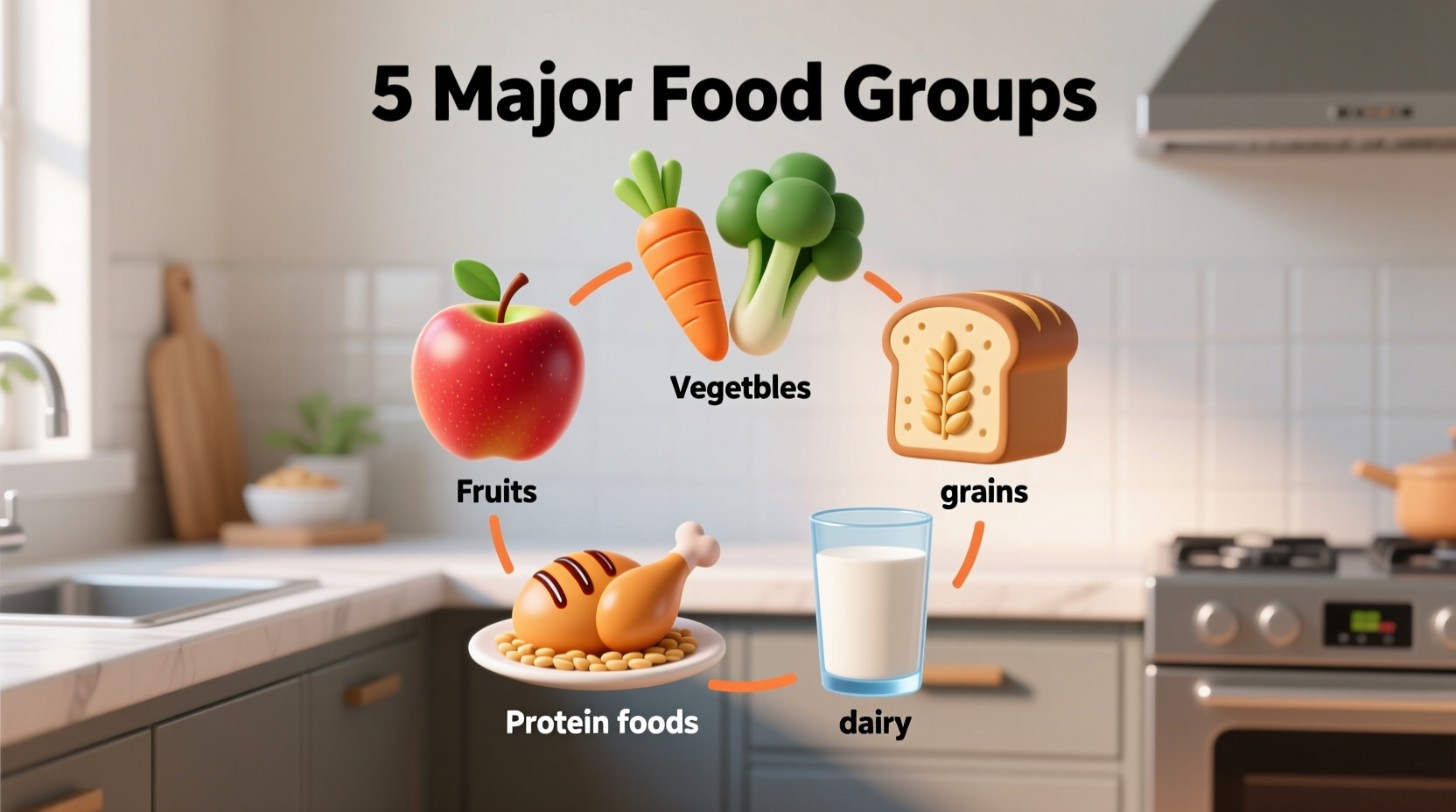Understanding food groups is essential for building balanced meals and maintaining optimal health. Whether you're planning menus, tracking nutrition, or simply trying to eat better, knowing how many food groups exist and how they function provides the foundation for informed dietary choices. This guide explores the science behind food classification systems and gives you practical tools to apply this knowledge daily.
Modern Food Group Systems Around the World
While the concept of categorizing foods isn't new, contemporary nutrition science has refined these systems to reflect current understanding of dietary needs. The most widely recognized framework today comes from the United States Department of Agriculture's MyPlate model, which identifies five essential food groups. But nutritional approaches vary globally, reflecting cultural eating patterns and scientific interpretations.
| Nutrition System | Food Groups | Unique Features |
|---|---|---|
| USDA MyPlate (USA) | 5 groups | Emphasizes visual plate division; includes oils as separate recommendation |
| Eatwell Guide (UK) | 5 main categories | Places starchy carbohydrates at foundation; includes "beans and pulses" in protein |
| Canada's Food Guide | 3 main categories | Focuses on food types rather than groups; emphasizes plant-based proteins |
| Australian Guide | 5 groups | Includes discretionary choices as separate category; specific serving recommendations by age |
This comparison reveals how cultural context shapes nutritional guidance while maintaining scientific integrity. The USDA system's five-group approach remains the most referenced framework globally, though adaptations exist to suit regional dietary patterns.
Evolution of Food Group Classification
Nutritional science has evolved significantly over the past century, with food group systems adapting to new research findings. Understanding this progression helps explain why certain classifications exist today:
- 1940s-1950s: The Basic Seven system included seven categories: green/yellow vegetables, oranges/tomatoes/cabbage, potatoes/other vegetables, milk group, meat group, bread/cereal, and butter/fats
- 1956: Simplified to The Basic Four: milk, meat, fruits/vegetables, and bread/cereal
- 1979: Introduced The Food Wheel with four groups: breads/cereals, fruits/vegetables, milk products, and meats
- 1992: USDA launched the Food Guide Pyramid with six groups including a separate fats/sweets category
- 2005: MyPyramid refined the approach with vertical bands representing food groups
- 2011: Current MyPlate model established the five-group system still used today
This historical progression demonstrates nutrition science's responsiveness to research. The shift from pyramid to plate format in 2011 specifically addressed criticism that previous models overemphasized grain consumption and didn't clearly illustrate portion proportions.
Practical Applications for Daily Eating
Knowing there are five food groups in the standard system is just the beginning. The real value comes from applying this knowledge to create balanced meals. Here's how to translate food group theory into practice:
Building Balanced Meals Using the Plate Method
Visualize your plate divided into sections that reflect the MyPlate proportions:
- Fill half your plate with fruits and vegetables (aim for variety in color)
- Devote one-quarter to protein foods (including plant-based options)
- Reserve one-quarter for grains (with at least half being whole grains)
- Include a serving of dairy (or fortified alternative) on the side

Special Considerations Across Life Stages
Food group recommendations aren't one-size-fits-all. Certain populations have specific nutritional needs that affect how food groups are applied:
- Children: Require appropriate portion sizes and may need modified textures; dairy remains crucial for development
- Older adults: Often need increased protein intake to maintain muscle mass while managing calorie needs
- Vegetarians/Vegans: Must strategically combine plant proteins to ensure complete amino acid profiles
- Athletes: Typically require higher carbohydrate intake from grains for energy needs
These context boundaries demonstrate why understanding the principles behind food groups matters more than rigidly following any single guideline. The core nutritional components remain consistent, but application varies based on individual needs.
Common Misconceptions About Food Groups
Several persistent myths can lead to confusion about food group classifications:
- "All grains are created equal": Whole grains provide significantly more fiber and nutrients than refined grains, though both fall under the grains group
- "Protein means only meat": Legumes, nuts, seeds, and soy products provide complete or complementary proteins without animal products
- "Fruit juice counts the same as whole fruit": Juices often lack fiber and contain concentrated sugars compared to whole fruits
- "Dairy is mandatory for everyone": Fortified plant-based alternatives can provide equivalent nutrients for those with lactose intolerance
These misunderstandings highlight why examining food composition within groups matters as much as recognizing the groups themselves. The USDA's inclusion of subgroup recommendations within each main category addresses these nuances.
Putting Food Groups Into Action
Understanding how many food groups exist becomes truly valuable when you implement this knowledge. Try these practical strategies:
- Weekly meal planning: Ensure each food group appears in your meal schedule throughout the week
- Supermarket navigation: Shop the perimeter first (where fresh produce, dairy, and proteins typically reside)
- Restaurant ordering: Choose dishes that naturally incorporate multiple food groups for balanced nutrition
- Snack smart: Combine elements from different groups (like apple slices with nut butter) for more satisfying snacks
Remember that variety within each food group matters as much as variety across groups. Different colored vegetables provide distinct phytonutrients, while various protein sources offer complementary amino acid profiles. This nuanced approach to the five food groups creates truly comprehensive nutrition.
Frequently Asked Questions
What are the 5 food groups in MyPlate?
The five food groups in the USDA MyPlate guidelines are fruits, vegetables, grains, protein foods, and dairy. Each group provides unique nutrients essential for health, and recommendations suggest incorporating foods from all five groups daily for balanced nutrition.
Why did food groups change from 4 to 5?
The change from four to five food groups occurred when dairy was separated from the meat/protein group to emphasize its unique nutritional profile, particularly calcium and vitamin D content. This refinement better reflected scientific understanding of dairy's specific health benefits, especially for bone health.
Do all countries use the same number of food groups?
No, food group systems vary internationally. While the USDA uses five groups, Canada's Food Guide organizes foods into three main categories, and some systems recognize six groups by separating plant-based proteins. These variations reflect cultural eating patterns while maintaining scientific nutritional principles.
How do I get all food groups on a vegetarian diet?
Vegetarians can meet all food group requirements by incorporating diverse plant-based options: dairy and eggs (if consumed) for dairy/protein, legumes and soy products for protein, plus ample fruits, vegetables, and grains. Vegans substitute fortified plant milks for dairy and combine complementary proteins like beans and rice to ensure complete amino acid profiles.
Are oils considered a food group?
Oils are not considered a separate food group in the USDA MyPlate system. Instead, they're recognized as important sources of essential fatty acids and are included as a recommendation within the healthy eating patterns. The USDA advises using oils in moderation as part of a balanced diet that includes all five food groups.











 浙公网安备
33010002000092号
浙公网安备
33010002000092号 浙B2-20120091-4
浙B2-20120091-4